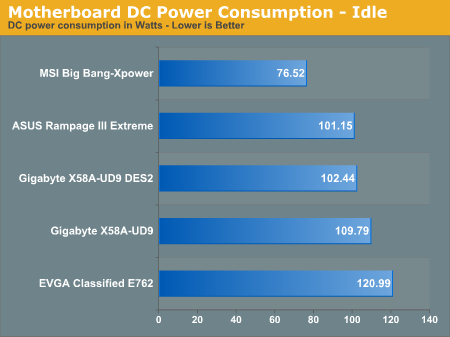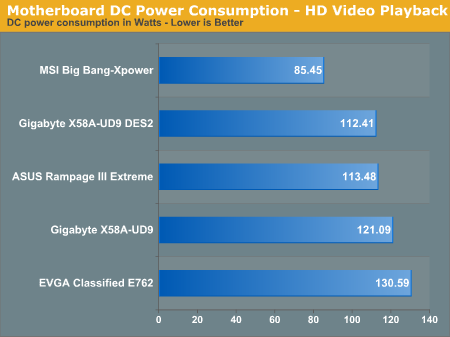ASUS, EVGA, Gigabyte & MSI: Four Flagship X58 Motherboards Reviewed
by Rajinder Gill on July 15, 2010 10:00 PM EST|
Testbed Setup Overclocking / Benchmark Testbed |
|
| Processor |
Intel i7-980X ES - 3.33GHz, 6 cores, 12 threads. 12MB L3 Cache Intel i7-980X Retail - 3.33GHz, 6 cores, 12 threads. 12MB L3 Cache |
| CPU Voltage | Various |
| Cooling | Intel air cooler, Heatkiller 3.0 waterblock, 2 x PA120.2 radiators and 2 x DDC ultra pumps (with Petra top) in series, 1/2 ID tubing for watercooling. |
| Power Supply | Corsair HX950, PCP Turbo Cool 1200W |
| Memory |
Corsair Dominator GT 8-8-8-24 2200MHz 4GB kit G.Skill Perfect Storm 8-8-8-24 2200MHz 4GB kit. |
| Memory Settings | Various |
| Video Cards | MSI N275 Lightning |
| Video Drivers | nVidia 197.45 WHQL |
| Hard Drive |
Western Digital 7200RPM 1TB SATA 3/Gbps 32MB Buffer OCZ Vertex 120GB SSD |
| Optical Drives | Plextor PX-B900A, Toshiba SD-H802A |
| Case |
Open Test Bed - Dimastech Benching Station Lian-Li V2110 |
| Operating System | Windows 7 64 bit |
| . | |
We utilized memory kits from Corsair and G.Skill to verify memory compatibility on our test boards. Our OS and primary applications are loaded on the OCZ Vertex 120GB SSD drive and our games operate off the WD Caviar Black 1TB drive. We did a clean install of the OS and applications for each motherboard. For graphics duty, MSI’s GTX N275 GPUs are used to provide performance comparisons between boards during gaming benchmarks.
For our test results we set up each board as closely as possible in regards to memory timings, Uncore, QPI frequency and also match up C-state parameters. The X58 boards utilized 6GB of memory throughout the course of benchmarking compares. Memory timings are set to 7-7-7-20 1T @ DDR3-1333 for the stock benchmarks and 8-8-8-24 1T DDR3-1600 for the 4GHz processor overclock compares.
We’ve recently updated our graphics drivers to nVidia’s WHQL 197.45 so are a little thin on platform compare results. However, there are a few reviews where gaming performance of X58, P55 and AMD platform compares have been made here and here.
Power Consumption
Our power consumption testing utilizes the same batch of components under similar circumstances in a bid to monitor variances between idle and CPU load conditions. We install the vendor supplied power saving utilities on each board and enable power saving modes that don't involve any kind of underclocking or CPU core frequency modulation in order to run an apples to apples comparison.
ATX PSU switching losses are absent from our figures because we monitor power consumption directly at the DC rails of the PSU. These figures measure only the CPU, motherboard, memory and GPU PCIe power draw via the motherboard and exclude any other peripherals, such as cooling fans and hard drives etc. Actual AC power consumption for the motherboard will be anywhere from 15~40% higher than these figures depending upon the efficiency of your power supply and choice of GPU.



Unsurprising that the MSI board comes out on top in these tests. Gigabyte’s UD9 fares well in comparison to the ASUS Rampage III Extreme with DES power saving modes engaged (considering it has two NF200 chips in tow). EVGA trails in all tests behind the UD9 for raw efficiency because the Volterra VRM used for CPU Vcore duty operates at a base switching frequency of 800KHz.










52 Comments
View All Comments
Etern205 - Friday, July 16, 2010 - link
Anyone notice the dual 8-pin on the Asus?EVM - Friday, July 16, 2010 - link
You guys make me laugh when you rip the makers of these boards!mobutu - Friday, July 16, 2010 - link
You have to be really crazy to spend $700 on a motherboard, video card or cpu.Or, for that matter, on any single pc component.
Acanthus - Friday, July 16, 2010 - link
This just in, 2 year old chipset performs identically to launch, give or take 1%.Intel needs to stop revoking the licenses of their competitors.
But then they couldn't have the best quarter ever during the worst economy in 70 years.
jonup - Friday, July 16, 2010 - link
Actually economy is doing just fine. If it wasn't for cheating sovereign government in Europe and the resulting debt crisis we would have been doing even better.kallogan - Friday, July 16, 2010 - link
I don't see the point really. They're just for geeky fanboys or benchmarks junky. Getting cheap computer parts and push them to their limits is a lot more fun ;-). Buying a celeron dual core E3200 and make it score more than a E8600, that is fun.It's like these memory kits :
Corsair Dominator GT 8-8-8-24 2200MHz 4GB kit
G.Skill Perfect Storm 8-8-8-24 2200MHz 4GB kit
.....
Dominator, perfect storm, extreme my a.... Everybody knows high-end memory kits are marketing jokes and brings absolutely nothing but 0,1 %.
Voldenuit - Friday, July 16, 2010 - link
Honestly, I think reviewing these things is a waste of time.I'd rather see reviews of real products that real enthusiasts would buy. Don't they have sites dedicated to LN2/cascade cooling overclocking and hardware?
I'd never spend more than $200 on a motherboard, and something closer to $120 would be more like it. I'd also rather find out how the options in that price space would suit my needs rather than read about expensive, impractical halo products on a platform that is going to be obsoleted in a few months by Sandy Bridge anyway.
jonup - Friday, July 16, 2010 - link
Man, this is like porn. It's what can't don't want to have, but like watching it anyways.Voldenuit - Saturday, July 17, 2010 - link
Nah, reading a $700 Thermaltake Level 10 case review is geekpr0n. A $700 motherboard based on a 2-year old chipset with no real performance or innovation gains is more like goatse. :pshin0bi272 - Friday, July 16, 2010 - link
If they dont really do anything new/better performance wise (save for sata6g, and usb3) and intel is changing sockets with the sandy bridge later this year then what's the point of reviewing these now?